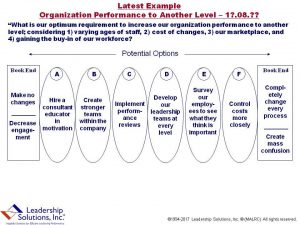by Peter A. Arthur-Smith, Leadership Solutions, Inc.®
“What is our optimum requirement to increase our organization performance?” Question posed by company CEO who was aiming to grow from a relatively small enterprise into a mid-sized business.
 |
He was sitting in the midst of about 20 other CEOs-senior executives. Clearly he was hoping they would share their group wisdom to enlighten his thinking. How many conventional CEO or executive forums have you attended, where you had hoped to reap a few pearls of wisdom? Too often, however, it was likely you weren’t able to optimize on the opportunity because you didn’t have a common framework or reference points with which you could compare notes. Good advice often goes out of the window because we’re not given a metaphor – or mind-picture – to help us fully assimilate it.
Your writer recently attended a major soccer game in Europe. The crowd was able to appreciate the ebbs and flows, individual and team performance, as well as the final outcome – which was a tie or “draw” in European parlance – because everyone was working within the same framework, with the same rules and with the same view of play. Most CEOs or executives from various organizations don’t have that possibility, because they’re all working within different markets, with different products or services; that is, they’re all using a somewhat different frame of reference. However, they do have similar leadership issues; although even those are governed differences in relative size or exactly where their enterprises are within their growth cycle. In sports, you tend to have similar standard teams playing each other in similar grade leagues.
One constant in the business world, is that so many companies utilize the traditional command-and-control mode of planning, organizing, directing and controlling. Our CEO, quoted at the outset, was attempting to lift himself out of that box, along with his other forum participants. Instead, they aimed to set their sights on entertaining enlightened leadership possibilities with its world of envisioning, positioning, engaging and collaborating. It advocates five phases of interlinked activity, namely – Decision Clarity, Pathfinding, People Motivation, Teamwork, and Momentum Building. Current readers have already been introduced to these five phases over time and so they will be familiar with the many benefits of utilizing them. In particular, you gain much higher levels of people engagement for the exact same investment.
As you can see, this article is devoted to Phase 1- Decision Clarity and therefore re-introduces you to its more advanced decision-making approach called Option Solving (OS). OS brings many powerful advantages to CEOs and senior executives, especially in their desire to upgrade organizational performance, as indicated at the outset. It offers a more optimal decision-making approach than your competitors right out of the gate, because they’re still sticking with either ad hoc or way-more rational, analytical approaches – usually resulting in either-or outcomes. OS offers a choice, out of a range of smart possibilities within your market or company, so you already have one considerable leg up.
One of OS’s many advantages is that it provides a sound framework with seven guiding principles, which will ultimately produce an actionable outcome. Hence it gives a group of CEOs or executives, or teams at any level, a common frame where each other is coming from. From this they can share value and insights through common reference points.
 |
Now take a look at the above option solving pictogram, which shows you the initial, rational question he and his CEO-executive cohorts developed. It also includes some key considerations:
»What is our optimum requirement to increase our organization performance to another level; considering 1) varying ages of staff, 2) cost of changes, 3) our marketplace, and 4) gaining the buy-in of our workforce?
Note the four considerations which are key to providing our intuitive minds the context from which an effective conclusion can reveal itself. The group did, in fact, produce more considerations, but deliberately stuck with these four primary ones to minimize complexity.
Option solving then guided them to produce two extremely unlikely “bookends;” namely – ‘Make no changes’ and‘Completely change every process.’ Being the most unlikely of choices, they spurred fertile, intuitive minds into conjuring-up at least 5 plausible options. They were able to pinpoint more than 5, but this is the minimum number prescribed within OS to adequately challenge our often dormant innovative minds to perceive an optimal range of options.
You can now spot the six options they developed as inspired by the original rational question. So let’s list them here for clarity:
» Hire a consultant, educator in motivation techniques.
» Create stronger teams within the company.
» Implement performance reviews.
» Develop our leadership teams at every level.
» Survey our employees to see what they think is important.
» Control our costs more closely.
Once their pictogram choices were clear, they were encouraged to take a break for some emotional distancing (ED). ED permits them to shut their pictogram away for an hour, two hours or several hours – including sleeping-on-it – and focus on something quite different. It creates a natural break for devoting some time for another task or issue. Meanwhile, their intuitive minds subconsciously cogitate over their pictogram – the picture makes it more memorable – and relate it to their life’s experiences and decisions. Just like that, their mind starts crystallizing around the most likely option.
When they returned as a group, they quickly reacquainted themselves with their pictogram and were invited to anony-mously disclose their decision-option: anonymity was requested so that “group think” wouldn’t occur. In this instance, the majority opted for Option D – Develop our leadership teams at every level. They actually saw leadership as the key ingredient. Now they were in a position to either put together an action initiative – consisting of what, how, who, when, and where (to go for allies) – OR ‘Peel the Onion’ for revealing sub-options to unearth an optimal approach to Option D.
In fact, they chose the latter course and so we will follow-through on that in two weeks time to see where they went with this revelation. By this time you will have noted that they asked the appropriate, all encompassing original question, they dismissed least likely options, and chose their optimal possibility from a range of interesting options. They weren’t trapped into either-or – not a good judgmental situation to be in for important decisions unless they’re fairly obvious.
So next time around, we’ll delve into Option D much more and determine what options lie behind “Taking this executive’s desire to increase his organization’s performance to another level: through developing his leadership teams at every level.” By reviewing a range of plausible options, we’re more likely to be satisfied that we’ve flushed out our optimal option or pathway, rather than being hemmed-in by either-or. The latter is not a particularly good place to be because it limits creativity and fresh alternatives.
To learn more about Option Solving and decision-making, talk with:
